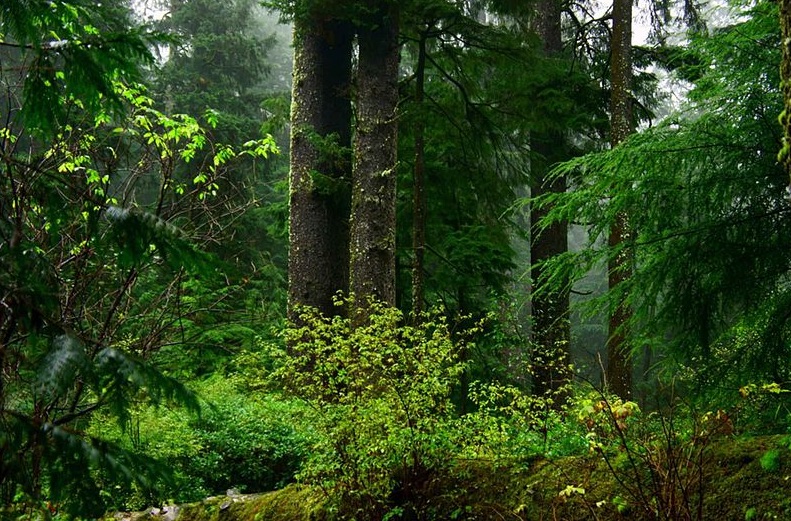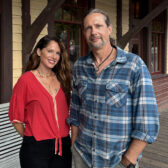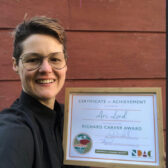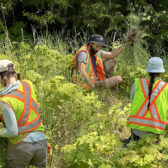Old-growth forest preservation has deep roots in wildfire resiliency: Valhalla Wilderness Society
The devastating wildfire season still gripping much of the West Kootenay underlines the need for the Province to make concerted efforts to preserve existing old-growth forests, according to a local environmental organization.
Speaking for the Valhalla Wilderness Society — based in New Denver — director Craig Pettittt said there is no question the current wildfire season could have been tempered if more old-growth forest had been left intact.
“The Minister of Forests has acknowledged that the province’s recent wildfire emergencies are worsened by climate change,” he said. “The need to save old-growth forest now, on the ground, is dire.”
In responding to questioning about how the sharp edge of the current wildfire season could have been dulled, Pettitt said preserving old-growth forests helps moderate B.C.’s fire situation through its role in “absorbing and storing the carbon dioxide in the atmosphere that causes climate change, which in turn causes extreme hot weather and drought, which increases the number, severity and speed of spread of wildfires.”
He stated that the greatest source of emissions in B.C. was the clear cutting and slash-burning of old-growth forests, as stated in a report by prominent B.C. forester Dr. Jim Pojar, (Forestry and Carbon in B.C., 2019).
Thicker skin
Pettitt said old-growth forest is more resistant to wildfire than a younger forest, according to scientific studies.
“The oldest and largest trees in forests like those in the Pacific Northwest play a vital role in carbon absorption and storage,” he explained.
“These old and diverse forests are resistant to wildfires due to the size and moisture content of the dead wood.”
- https://www.politico.com/news/magazine/2023/06/11/to-fight-wildfire-our-forests-need-to-grow-old-00101360, New Trees are no substitute for old Tree, Christenson, N. and Franklin, J., Politico, 2023
The book — written by two retired professors of environmental science and forest ecology — details the fire risk associated with forests at different stages in their growth. The youngest (immature) forests are said to be at high risk of wildfire, Pettitt said, while the older (mature) forest has fewer but larger trees.
“The canopy shades the understory and keeps it moist; because of this moisture, the dead wood in the forest is less likely to burn. Old-growth forest is even less likely to burn, and old-growth rainforest may have a thousand or more years between burns,” he said.
The primeval forest in the Incomappleux Valley has been growing uninterrupted since the last Ice Age — some scientists believe — Pettitt stated, while a court testimonial from a fuels specialist for the U.S. Bureau of Land Management was more specific.
“He said the greatest risk of a fire start is in the first five years after a clearcut. Fire hazard would increase for five to 20 years following planting, with fires becoming more intense, with high flame lengths and rapid speed of spread, then drop from high to moderate,” he said.
- https://www.evergreenalliance.ca/portal-increase-in-forest-fire-hazard/1/, Clearcut logging increases forest fire risk, Broadland, D, 2021
Prominent B.C. forester, Herb Hammond, explained the role of old forests in greater detail, said Pettitt.
“Forests, particularly as they grow older, conserve water in large part due to complex, multi-layer canopies, and overall composition and structure that are all geared to slowing the movement of water through the forest, while filtering and storing water at the same time,” he said. “Clearcuts, on the other hand, expose the land to rapid water loss.”
If a tree falls …
Unfortunately, the majority of clear-cutting has taken place in old-growth forests, said Pettitt, turning fire-resistant forests into the most ignitable forests.
Even if the clear-cut was adjacent to old-growth forests, the forest would be more vulnerable to fire since the drying effect would take place on the surrounding areas.
“Recently, there was a fire in the relatively new Ancient Forest Park near Prince George, in inland temperate rainforest that has the biggest trees so far found. However, to date that fire is very small and under control,” said Pettitt.
A study by the U.S. Forest Service showed that old-growth forests are less likely to experience high-severity fire than young-growth forests during wildfires.
“They found that old-growth forest was up to three times more likely to burn at low severity — a level that avoided loss of … habitat and is generally considered to be part of a healthy forest ecosystem,” he said.
- https://research.fs.usda.gov/pnw/news/releases/old-growth-forests-may-provide-valuable-biodiversity-refuge-areas-risk-severe , Old-growth forests may provide valuable biodiversity refuge in areas at risk of severe fire, USDA, 2019.
The new normal
Pettitt said four realities face the province, including climate change increasingly breaking all former weather patterns related to storms, fires and insect infestations.
As well, even though old-growth forests are increasingly threatened, it remains the most fire-resistant forests in B.C., the ones most likely to endure the increasing climate crisis.
Those same old-growth forests are “crucial bulwarks against climate change, by removing carbon from the atmosphere and storing it,” said Pettitt, adding that clearcutting old-growth forests releases huge quantities of carbon into the atmosphere, increasing the fire hazard.
“The sea of clearcuts across the province has given us landscapes with far higher fire hazard,” he said. “Recent research has shown that large, old trees are more resistant to drought than small trees, and in other studies, that old-growth has a cooling effect on its surrounding area and on the planet.”
- https://www.theguardian.com/environment/2022/mar/23/forests-climate-crisis-carbon-cooling effect, The world’s forests do more than just store carbon, new research finds, Lakkhani, N., The Guardian, 2022.
Too little, too late
The Slocan Valley wildfires are not much relevant to the old-growth discussion because most, if not all, of the burned forest is not old-growth, said Pettitt, or else it is small tree, old growth growing on steep or rocky slopes.
Logging has taken place in the valley since the turn of the century — long before Valhalla Park was created — on the inland temperate rainforest comprised of Interior cedar-hemlock (ICH) forest, not all of which is rainforest. There are dry, moist and wet variants of ICH, said Pettitt.
“Slocan Valley forest is mostly moist ICH. Historical fire return intervals are estimated by some sources to be 200 to 300 years, but there are stumps and remnant live cedar trees in the valley that would be in the 250 to 500-year range,” he said.
“What is demonstrated in our landscape is that, where some big, old trees can be found, they are there because they are in particularly wet sites, often with high water tables, that have been passed over by fires.
“In fact, we have pockets of old trees surrounded by second-growth forest from wildfires that left behind the old-growth.”
Wet forest types such as Sitka spruce-hemlock-cedar forests of the coast, or subalpine areas in the Interior, or the wettest areas of the Interior inland rainforest, were not shaped by fire and do not need it, he added.
Moving forward
With no old-growth forest to protect Slocan Valley communities, there needs to be more fire smarting of the surrounding forest, said Pettitt.
“This is very different from selection logging, which takes the biggest trees and leaves the rest. Fire smarting takes the small trees and leaves the big ones,” he said. “We don’t have many big trees near our communities, but quite a bit of removal of small trees has been done in key areas.”
Fire smarting wildlands by thinning is said by experts to be impractical, Pettitt related, so the recommendation is that it should be focused directly around communities.
“With climate change advancing, another thing we see is for the government to invest much more in fire-fighting capability. It has made improvements even since last year,” he said. “When residents on Red Mountain Road were evacuated because of the Aylwin and Komonko fires, a structure protection crew went to work on the most threatened houses. This was very appreciated.”

























